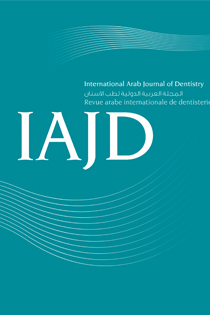Résumé
The purpose of this study was to evaluate the shear bond strength (SBS) of amalgam to dentin using four different bonding systems. Eighty extracted human third molars of approximately the same size were selected. Teeth were sectioned parallel to the occlusal plane to expose mid-coronal dentin, and then onehalf of each tooth was embedded in acrylic resin. Four bonding systems were used following manufacturers’ recommendations. Enamel and dentin surfaces on teeth being restored with amalgam bonding were etched, rinsed, single-coated with primer/ adhesive, restored with Valiant PhD-XT using condensation to intermingle amalgam with setting adhesive, light cured (30 sec) and conditioned (distilled water, 37°C, 24h). Half of all specimens were thermocycled for 24 hours (5°C/55°C, 1 min dwell times, 500 cycles). All specimens were macro shear bond strength tested (loading rate of 1mm/min, 25°C, knife edge texted). Results (MPa = failure load/ bond area) for groups (n=10) were statistically analyzed (2-way ANOVA, Tukey-Kramer post hoc tests, p≤0.05). Shear bond strength of thermocycled groups was the greatest (p<0.05). Results for groups 1-4 for storage only (6.7±1.6, 6.5±1.0, 3.6±0.9, 6.4±2.5) versus thermocycled (13.3±3.0, 15.1±4.9, 15.4±4.7, 18.2±5.8) showed essentially no bonding system effect and no interaction of bonding system with thermocycling. After thermocycling, the adhesive mode of failure was most common.

